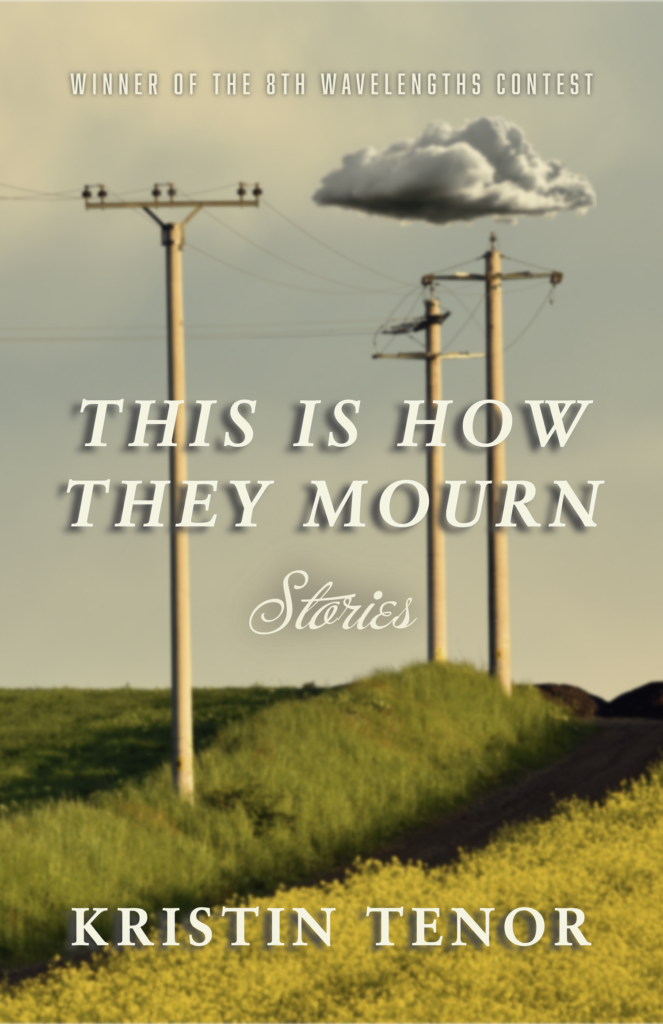By Charlotte Hamrick
Kristen Tenor’s This is How They Mourn (Thirty West Publishing House) is a collection of flash and micro fiction that reads like memoir. The pieces are intimate, pulling the reader into stories of sacrifice, pain, regret but always with a foundation of love and discovery. I agree with the blurb on the back cover that “Kristin is one of the best writers currently working in the short form.” Kristin shares her writing process and inspirations in this thoughtful book interview.
Q: A fragment of the blurb by Kathy Fish for This is How We Mourn states, “Tenor guides us through the liminal spaces and haunting landscapes of human experience.”
That is exactly what strikes me in your writing and in this book in particular. You have a talent for taking the reader between the lines, within the words, and around events that is quite remarkable. I’m curious if it’s an innate talent, a technique you’ve perfected over time, or maybe a combination of both?
A: Thanks so much for your kind words about my work, Charlotte—and to Kathy as well. This is such an interesting question. When I sit down to write, I try to approach the page with not only a sense of curiosity but also empathy. Building a resonant connection between the character and the reader has always been very important to me.
With flash fiction in particular, the compression requires the reader to be an active participant by drawing upon their own experiences and emotions so they might better understand the character’s yearning. Therefore, the imagery or details within the piece must carry a certain weight or nostalgia.
One of my dear friends, who passed away a few years ago, lost most of her eyesight due to macular degeneration. When we visited, she often asked me to be “her eyes,” to describe things in the minutest detail so she, too, could experience their beauty. Sometimes I feel as though she’s still here listening to me tell stories.
How a reader interprets the liminal space in a story is, I believe, a reflection upon what they’ve emotionally carried into it—and I consider myself just as much a reader as anyone. However, as a writer, all one can do is provide the bridge to walk across.
Q: In “Familiar Talk” you play with the concept of time in a kind of list that’s not at all a dry numerical listicle but one that moves like water within the banks of a paragraph. Indeed, you do mention grocery lists in addition to a girl who sat in your school bus, an opossum, and fancy French perfume. All of this and more, plus a simile of a Mother bear in the backyard, are woven together into a cohesive whole. How did this extraordinary piece come together?
A: I wrote this story mainly in response to a prompt Kathy Fish shared in her Flash Immersion Extravaganza last February. As part of the exercise, she encouraged us to visit Project Gutenberg to search for interesting phrases and/or tidbits that sparked our curiosity. I found a book titled Common Sense in the Household: A Manual of Practical Housewifery written by Marlon Harland in 1883. The first line of the opening chapter reads: “A talk as woman to woman, in which each shall say, “I,” and “you,” and “my dear,” and “you know,” as freely as she pleases.”
Around the same time, one of my friends forwarded me an interesting LitHub article written by Gloria Dickie on how climate change has altered North American black bears’ biological clocks to the point some have ceased hibernating. Dickie compared the bears to insomniacs rummaging through the fridge in the middle of the night.
Being a woman of a certain age and a frequent insomniac myself, one night I imagined what it might be like to talk woman to woman with a mother black bear at 3 A.M., to unleash everything flitting through one’s mind and well…
The passage of time is such a complicated beast, isn’t it? The older I get, the faster and faster the days and weeks seem to slip by. This alone creates a certain breathlessness—much like the list that never seems to end for the woman in this story.
Q: Another stand-out piece was “Assemblage or How to Piece Together a Crazy Quilt Without Losing Yourself”. Its hybrid form and historical elements were interesting and really enhanced the prose. How much research went into the historical details of this piece and can you share a little about the thought process in creating it?
A: Most of what I know about quilting I’ve learned from my grandmother, who unfortunately passed away the winter before I turned twelve years old. I spent many afternoons watching her piece together the fabric scraps she kept near her sewing machine. She also hosted the occasional quilting bee in the middle of her living room. I remember how she and my great aunts pinned and basted and hand-stitched the batted layers together with great skill and care, while they gossiped and scolded one another for talking too much.
One of the quilts my grandmother made included fabric cut from my grandfather’s ties and work shirts, as well as my uncle’s U.S. Naval uniform and dresses my mother and her sisters wore perhaps to school dances or church on Easter Sunday. I’ve often wondered why she chose to preserve these particular pieces of clothing and what memories—happy or sad—they evoked in her.
As far as the historical details included in the story, I read an excellent overview of the history of the crazy quilt in the book Crazy Quilts: History-Techniques-Embroidery Motifs by Cindy Black as well as an online article in British Heritage Travel about the sentimental items Queen Victoria requested be buried with her, including the plaster cast of Prince Albert’s hand.
I consider “Assemblage or How to Piece Together a Crazy Quilt Without Losing Yourself” a complete work of fiction; however, these are the main inspirations that led me down this particular rabbit hole.
Q: The threads of a brother and grief surfaced in several pieces; “This is How They Mourn” and “Born Again Brother” come to mind, of course, but I’m guessing the brother is also in “How to Leave Without Saying Good-bye” and “The Carnival Ride Isn’t Over.” All of these stories are poignant and I’m wondering if they were cathartic for you and can you talk a little about catharsis in writing.
A: I’m honestly not sure why brothers appear so often in my work. In my own family, I’m the oldest of three daughters and also have two daughters of my own. However, that doesn’t mean I haven’t observed or experienced similar grief during my lifetime and perhaps fictionalizing it in this way has been a part of the catharsis you mention—a way to let go and allow it to reside somewhere else for a while.
“How to Leave Without Saying Goodbye” is the only piece in this collection I’d classify as creative nonfiction. I wrote it in homage to my Uncle Pete, who died of cancer in his early fifties. The car ride we took to see a man about a lawnmower is one I’ll never forget. I believe writing this story has been an attempt to keep this memory, the lesson to appreciate the present moment, alive and well.
Q: “Take What is Left” is skillfully and sensitively written. I don’t want to give it all away because it needs to be read to be appreciated. Again, you’re writing within a liminal space and it works so well here. You write “…don’t look the doctor in the eye…” and later the “unwrapping” scene illustrates so well the anxiety and fear of the unknown to come. Then I had to go back and reread “Vigilia” because they felt like two sides of the same coin. Are they?
A: I love what you’ve said about these stories being two sides of the same coin, Charlotte. They do appear to be in conversation with one another; however, the intent for them to do so wasn’t necessarily a conscious one on my part. And yet, it’s intriguing how these parallels and themes emerge organically over time, how one story informs the next then the next and so on.
James Baldwin once said, “Every writer has only one story to tell, and he has to find a way of telling it until the meaning becomes clearer and clearer until the story becomes at once more narrow and larger, more and more precise, more and more reverberating.”
I find Baldwin’s words so wise and true. It seems no matter what story I write I’m always searching for some kind of closure between unexplainable loss and what remains.
Q: What was the most challenging aspect of putting this collection together?
A: In Edwidge Danticat’s craft book, The Art of Death: Writing the Final Story (Graywolf Press, 2017), she says, “We cannot write about death without writing about life.” While pulling this collection together, I sometimes worried about maintaining enough balance between the two. I didn’t want these stories to come across as maudlin or just a compilation of tragic moments but to instead acknowledge and give witness to the multi-layered, complex humanity behind them. At the same time, I understand the importance of trusting the reader. How the collection is received is ultimately up to them.
Q: What advice would you share for someone wanting to put together a collection for the first time?
A: First, be patient with both the process and yourself. The stories in This Is How They Mourn were written over an eight year span, and for every piece included, several others never saw the light of day and that’s fine. No words are ever wasted.
It also might be helpful to consider how the ebb and flow of your pieces create a dialogue between your character and the reader. In some ways, it’s sort of like making a mixtape (yes, the 80s rocked) or a playlist for someone you deeply care about. How do your pieces juxtapose or complement one another? How do they support the theme but also build an emotional arc? In my opinion, both are vital.
Q: I know in your writing journey you’ve been encouraged by a number of writers. Is there one person or one workshop that you feel was an a-ha! moment of inspiration?
A: About nine years ago, I attended a summer writing retreat at the University of Wisconsin-Madison, where I participated in a short story workshop facilitated by Chris Chambers. One of the first pieces Chris introduced to our cohort was Robert Hass’ “A Story About a Body.” Without giving away too much here, the piece concludes with the lasting image of a blue bowl filled with dead bees covered by rose petals, and it’s stayed with me to this day. The way Hass manages to meld narrative and emotion in such a sensitive, complex way through image and implication alone exhibits real artistry to me. It’s something I continually strive for in my own writing.
Q: What is next for you? Can we look forward to another book or publication that you can share?
A: I’m currently working on a linked short story collection where all the stories take place the day man first walked on the moon. Although these characters share the common experience of witnessing the impossible become possible, they also each grapple with their own unique set of problems to solve. It’s intriguing how the ordinary details of such a historic event have a way of imprinting themselves on one’s memory. We so often associate the moon landing with families huddled around their television sets, everyone on the edge of their seats holding their collective breath. And yet, what else happened that day or evening? The juxtaposition between the everyday challenges we face and the extraordinary has always fascinated me. I’m interested in exploring how they intersect one another and define this crazy experiment we call life.


Kristin Tenor is the author of This Is How They Mourn, which won Thirty West Publishing House’s 8th Wavelengths Chapbook Contest. Her fiction has appeared in Best Microfiction 2024, Wigleaf, 100-Word Story, and various other literary journals and anthologies. Her work has also been nominated for Best of the Net, Best Small Fictions, and the Pushcart Prize as well as longlisted for the Wigleaf Top 50. She currently serves as the Reviews Editor at Story. Read more at www.kristintenor.com.

Charlotte Hamrick’s creative writing and photography has been published in a number of literary journals and anthologies including Still: The Journal, The Citron Review, Atticus Review, Reckon Review, Trampset, and New World Writing, among many others. Her fiction was selected for the Best Small Fictions 2022 and 2023 anthologies and she’s had several literary nominations including the Pushcart Prize, Best of the Net, Best Small Fictions, and Best Microfiction. She was formerly Creative Nonfiction Editor for The Citron Review and Barren Magazine. She also writes intermittently on her Substack, The Hidden Hour. She lives in New Orleans with her husband and a menagerie of rescued pets where she sometimes does things other than read and write.

One response to “THE NITTY GRITTY INTERVIEW WITH KRISTIN TENOR”
I only got as far as “Familiar Talk” before knowing I must read this book.